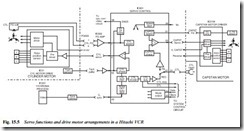TILTING DRUM TECHNOLOGY
While a wide-head design can give excellent still-frame picture reproduction, playout of ‘search’ pictures in forward and reverse directions always gives rise to noise bars across the picture in conventional videorecorder designs – it is the inevitable result of multiple track crossings by the replay heads, as described on page
280. To overcome the problem JVC designed a tilting head drum (Dynamic Drum, DD System) in which the entire drum assembly is canted, under servo control, to align the head sweeps with the tape tracks in search-forward and reverse-play modes; the effect and results are shown in Fig. 15.6, while Fig. 15.7 gives an idea of the working of the drum-tilt mechanism. In the rest state (record and normal-replay modes) the underside of the lower drum rests on four
fulcrum points. To tilt the assembly, the screws are rotated together by a motor so that the lower drum rests on two fulcrums whose individual heights are governed by the screw settings, and set by a servo loop whose reference is the off-tape video-f.m. signal. The total movement is measured in microns only, and has great precision and stability.
